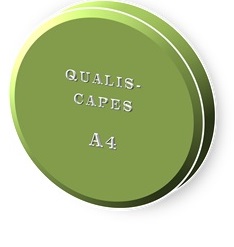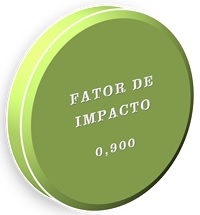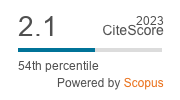Action of abiotic elicitors and nutritional solutions on yellow bell pepper using hydroponic system
DOI:
https://doi.org/10.1590/1983-21252025v3812776rcKeywords:
Capsicum annuum L.. Salt stress. Tolerance.Abstract
The aim of this study was to evaluate the contents of photosynthetic pigments, growth and production of yellow bell pepper under saline nutrient solutions and application of abiotic elicitors in a hydroponic system. The study was conducted in a greenhouse belonging to the Federal University of Campina Grande, Campus of Pombal, PB, Brazil. The cultivation was carried out under an hydroponic system, using a completely randomized design, with split plots. The main plots consisted of three levels of electrical conductivity of the nutrient solution - ECns (2.1, 3.1, and 4.1 dS m-1), while the subplots consisted of abiotic elicitors (control; salicylic acid, proline, and hydrogen peroxide), with three replicates. The concentrations of salicylic acid, proline, and hydrogen peroxide were 3.6 mM, 10 mM, and 40 μM, respectively. Salicylic acid at a concentration of 3.6 mM led to smaller height of yellow bell pepper plants under ECns of 2.1 dS m-1. However, salicylic acid, proline, and hydrogen peroxide at concentrations of 3.6 mM, 10 mM, and 40 μM, respectively, increased the synthesis of photosynthetic pigments and biomass accumulation. The use of 40 μM hydrogen peroxide and 3.6 mM salicylic acid resulted in higher chlorophyll total, carotenoids, and total dry matter contents in yellow bell pepper under ECns of 4.1 dS m-1. Electrical conductivity of the nutrient solution of 3.1 dS m-1 promoted a greater number of fruits in yellow bell pepper.
Downloads
References
AHMAD, A. et al. Effect of exogenous application of osmolytes on growth and yield of wheat under drought conditions. Journal of Environmental and Agricultural Sciences, 21: 6-13, 2019.
ALMEIDA, A. H. B.; ALMEIDA, H. S. A.; OLIVEIRA, M. K. T. Perspectivas da gestão hídrica no semiárido brasileiro para a irrigação. Disciplinarum Scientia| Naturais e Tecnológicas, 22: 119-132, 2021.
ALVARES, C. A. et al. Koppen’s climate classification map for Brazil. Meteorologische Zeitschrift, 22: 711-728, 2013.
ARAGÃO, J. et al. Hydrogen peroxide in the mitigation of salt stress in bell pepper. Semina: Ciências Agrárias, 44: 217-236, 2023.
ARNON, D. I. Copper enzymes in isolated cloroplasts: polyphenoloxidases in Beta vulgaris. Plant Physiology, 24: 1-15, 1949.
BAYRAM, D.; DINLER, B.S.; TASCI, E. Differential response of bean (Phaseolus vulgaris L.) roots and leaves to salinity in soil and hydroponic culture. Notulae Botanicae Horti Agrobotanici Cluj-Napoca, 42: 219-226, 2014.
BOUZROUD, S. et al. Salt stress responses and alleviation strategies in legumes: a review of the current knowledge. 3 Biotech, 13: e287, 2023.
DORNELES, A. O. S. et al. Responses of Solanum tuberosum L. to water deficit by matric or osmotic induction. Potato Research, 64: 515-534, 2021.
EL MOUKHTARI, A. et al. How does proline treatment promote salt stress tolerance during crop plant development? Frontiers in Plant Science, 11:e553924, 2020.
FARHADI, N.; GHASSEMI-GOLEZANI, K. Physiological changes of Mentha pulegium in response to exogenous salicylic acid under salinity. Scientia Horticulturae, 267: e109325, 2020.
FENG, D. et al. Categories of exogenous substances and their effect on alleviation of plant salt stress. European Journal of Agronomy, 142: e126656, 2023.
GUEDES, M. A. et al. H2O2 as attenuator of salt stress on the physiology and growth of hydroponic cherry tomato. Revista Caatinga, 37: e12002, 2024.
HOAGLAND, D. R.; ARNON, D. I. The water-culture method for growing plants without soil. 2. ed. Circular. Berkeley: California Agricultural Experiment Station, 1950. n. 347, 32 p.
IBGE - Instituto Brasileiro de Geografia e Estatística. Sistema IBGE de recuperação automática – SIDRA: censo agropecuário 2017. Resultados definitivos. 2017. Available at: <https://sidra.ibge.gov.br/pesquisa/censo-agropecuario/censo-agropecuario-2017>. Access on: May 2, 2025.
LICHTENTHALER, H. K.; BABANI, F. Contents of photosynthetic pigments and ratios of chlorophyll a/b and chlorophylls to carotenoids (a+b)/(x+c) in C4 plants as compared to C3 plants. Photosynthetica, 60: 3-9, 2022.
LIMA, G. S. et al. Irrigação com águas salinas e aplicação de prolina foliar em cultivo de pimentão ‘All Big’. Comunicata Scientiae, 7: 513-522, 2016.
MARENGO, J. A. et al. Assessing drought in the drylands of northeast Brazil under regional warming exceeding 4 ºC. Natural Hazards, 103: 2589-2611, 2020.
MENDONÇA, A. J. T. et al. Salicylic acid modulates okra tolerance to salt stress in hydroponic system. Agriculture, 12: e1687, 2022.
OLATUNJI, T. L.; AFOLAYAN, A. J. The suitability of chili pepper (Capsicum annuum L.) for alleviating human micronutrient dietary deficiencies: A review. Food Science & Nutrition, 6: 2239-2251, 2018.
RICHARDS, L. A. Diagnosis and improvement of saline and alkali soils. 1. ed. Washington: U. S. Department of Agriculture, 1954. 160 p. (Agriculture Handbook, 60).
SANTOS, A. C. et al. Brackish water: an option for producing hydroponic Capsicum annuum in laminar flows of mineral nutrients. Revista Colombiana de Ciencias Horticolas, 12: 147-155, 2018.
SCOTTI-CAMPOS, P. et al. Physiological responses and membrane integrity in three Vigna genotypes with contrasting drought tolerance. Emirates Journal of Food and Agriculture, 25: 1002-1013, 2013.
SHARMA, A. et al. Phytohormones regulate accumulation of osmolytes under abiotic stress. Biomolecules, 9: e285, 2019.
SHARMA, P. et al. Reactive oxygen species, oxidative damage, and antioxidative defense mechanism in plants under stressful conditions. Journal of Botany, 2012: e217037, 2012.
SIDDIQUI, S. A. et al. Photosynthetic gas exchange and chlorophyll a fluorescence in Salicornia brachiata (Roxb.) under osmotic stress. Journal of Plant Growth Regulation, 41: 429-444, 2022.
SILVA, A. A. R. et al. Salicylic acid alleviates the effects of salt stress on the physiology, growth, and production of hydroponic okra. Arid Land Research and Management, 37: 602-618, 2023.
SILVA, A. A. R. et al. Salicylic acid as an attenuator of salt stress in soursop. Revista Caatinga, 33: 1092-1101, 2020.
SIMKIN, A. J. et al. The role of photosynthesis related pigments in light harvesting, photoprotection and enhancement of photosynthetic yield in plant. Photosynthesis Research, 152: 23-42, 2022.
VELOSO, L. L. S. A. et al. H2O2 alleviates salt stress effects on photochemical efficiency and photosynthetic pigments of cotton genotypes. Revista Brasileira de Engenharia Agrícola e Ambiental, 27: 34-41, 2023.
WEATHERLEY, P. E. Studies in the water relations of the cotton plant. I - the field measurements of water deficits in leaves. New Phytologist, 49: 81-87, 1950.
Downloads
Published
Issue
Section
License
Os Autores que publicam na Revista Caatinga concordam com os seguintes termos:
a) Os Autores mantêm os direitos autorais e concedem à revista o direito de primeira publicação, com o trabalho simultaneamente licenciado sob a Licença Creative Commons do tipo atribuição CC-BY, para todo o conteúdo do periódico, exceto onde estiver identificado, que permite o compartilhamento do trabalho com reconhecimento da autoria e publicação inicial nesta revista, sem fins comerciais.
b) Os Autores têm autorização para distribuição não-exclusiva da versão do trabalho publicada nesta revista (ex.: publicar em repositório institucional ou como capítulo de livro), com reconhecimento de autoria e publicação inicial nesta revista.
c) Os Autores têm permissão e são estimulados a publicar e distribuir seu trabalho online (ex.: em repositórios institucionais ou na sua página pessoal) a qualquer ponto antes ou durante o processo editorial, já que isso pode gerar alterações produtivas, bem como aumentar o impacto e a citação do trabalho publicado (Veja O Efeito do Acesso Livre).







